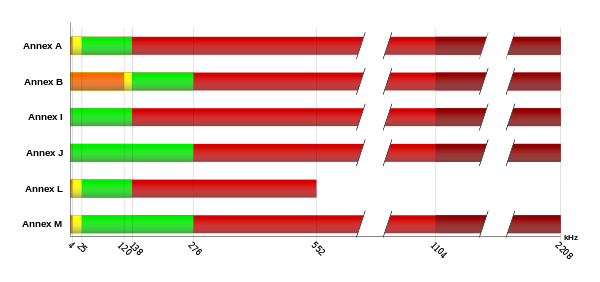G.992.5 Annex M: Difference between revisions
Numbermaniac (talk | contribs) Added {{no footnotes}} tag to article (Twinkle) |
Numbermaniac (talk | contribs) mNo edit summary |
||
| Line 9: | Line 9: | ||
|#900000|Additional Downstream ADSL2+| |
|#900000|Additional Downstream ADSL2+| |
||
}}]] |
}}]] |
||
The main difference between this specification and Annex A is that the upstream/downstream frequency split has been shifted from 138 [[kHz]] up to 276 kHz (as in Annex B/[[ITU G.992.3 Annex J|Annex J]]), allowing upstream bandwidth to be increased from 1.4 Mbit/s to 3.3 Mbit/s, with a corresponding decrease in download bandwidth. |
The main difference between this specification and Annex A is that the upstream/downstream frequency split has been shifted from 138 [[kHz]] up to 276 kHz (as in Annex B/[[ITU G.992.3 Annex J|Annex J]]), allowing upstream bandwidth to be increased from 1.4 Mbit/s to 3.3 Mbit/s, with a corresponding decrease in download bandwidth. |
||
== |
==Deployment== |
||
This standard was approved for deployment on Australian networks by the Australian Communications Industry Forum (ACIF). |
This standard was approved for deployment on Australian networks by the Australian Communications Industry Forum (ACIF). |
||
| Line 28: | Line 26: | ||
* [http://www.billion.com/edu/AnnexM_Whitepaper.pdf White Paper on Annex M] |
* [http://www.billion.com/edu/AnnexM_Whitepaper.pdf White Paper on Annex M] |
||
{{DSL technologies}} |
{{DSL technologies}} |
||
[[Category:Digital subscriber line|G.992.5 Annex M]] |
[[Category:Digital subscriber line|G.992.5 Annex M]] |
||
Revision as of 07:02, 23 December 2017
This article includes a list of references, related reading, or external links, but its sources remain unclear because it lacks inline citations. (December 2017) |
Annex M is an optional specification in ITU-T recommendations G.992.3 (ADSL2) and G.992.5 (ADSL2+), also referred to as ADSL2 M and ADSL2+ M. This specification extends the capability of commonly deployed Annex A by more than doubling the number of upstream bits. The data rates can be as high as 12 or 24 Mbit/s downstream and 3 Mbit/s upstream depending on the distance from the DSLAM to the customer's premises.

Legend POTS/ISDN Guard Band Upstream Downstream ADSL/ADSL2 Additional Downstream ADSL2+ |
The main difference between this specification and Annex A is that the upstream/downstream frequency split has been shifted from 138 kHz up to 276 kHz (as in Annex B/Annex J), allowing upstream bandwidth to be increased from 1.4 Mbit/s to 3.3 Mbit/s, with a corresponding decrease in download bandwidth.
Deployment
This standard was approved for deployment on Australian networks by the Australian Communications Industry Forum (ACIF).
